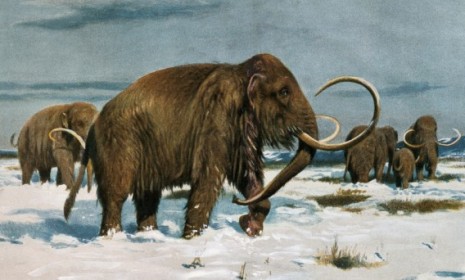Cloning the woolly mammoth: A worrying precedent?
A team of scientists is attempting to resurrect the woolly mammoth — a species that has been extinct for thousands of years. Is this Jurassic Park science unethical?

The woolly mammoth, an 8-ton, 13-foot-tall behemoth that is an icon of the last ice age, has been extinct for about 10,000 years. But Akira Iritani, a professor at Japan's Kyoto University, is confident that he can re-create a fully functioning replica by 2016. Using an innovative frozen-cloning technique, Iritani's plan sounds straight out of the movies: implanting a mammoth's cells into an elephant, in the hopes that the elephant will give birth to a baby woolly mammoth in four to six years. Is this realistic or science fiction?
What is Iritani's technique?
Iritani and his research team will use a method pioneered by Dr. Teruhiko Wakayama, who in 2008 "cloned a mouse that had been in deep freeze for 16 years," according to The Huffington Post. Before that breakthrough, Iritani's team had struggled with how to "safely extract DNA" from frozen cells, failing in three cloning attempts since 1997 because mammoth skin and muscle cells they got from Siberia had been permanently damaged by frost. This time, the team will use DNA from a mammoth carcass preserved in a Russian research lab, according to Yomiuri Shimbun. Then, following Wakayama's method, they will insert the nuclei of mammoth cells into an African elephant's egg cells that have had the nuclei removed — a process that could take two years. The last step is a 600-day gestation period, after which Iritani expects a fully formed baby mammoth to pop out of the elephant.
The Week
Escape your echo chamber. Get the facts behind the news, plus analysis from multiple perspectives.

Sign up for The Week's Free Newsletters
From our morning news briefing to a weekly Good News Newsletter, get the best of The Week delivered directly to your inbox.
From our morning news briefing to a weekly Good News Newsletter, get the best of The Week delivered directly to your inbox.
Will this actually work?
"The success rate in the cloning of cattle was poor until recently, but now stands at about 30 percent, says Iritani, as quoted by The Daily Tech. "I think we have a reasonable chance of success and a healthy mammoth could be born in four or five years."
What about the moral consequences?
Iritani "realizes the potential ramifications of this procedure," says The Huffington Post. He has said that "if a cloned embryo can be created, we need to discuss, before transplanting it into the womb, how to breed it and whether to display it to the public." He also plans to focus on the mammoth's "ecology and genes to study why the species became extinct and other factors." True, says Bob Etier at Technorati, it's important to understand why the species died off — but "isn’t anyone else suspicious of the mysterious 'other factors'?" Iritani should be careful not to mess with nature; if he "slept through the ending" of Jurassic Park, "he has no idea what he's getting himself into."
A free daily email with the biggest news stories of the day – and the best features from TheWeek.com
Sources: PC Magazine, Yomiuri Shimbun, Daily Tech, Huffington Post
-
 The week’s best photos
The week’s best photosIn Pictures A fireman's ladder, a race through the desert, and more
-
 NASA discovered 26 microbes in their cleanrooms
NASA discovered 26 microbes in their cleanroomsUnder the radar The bacteria could contaminate space
-
 The elite falcon trade in the Middle East
The elite falcon trade in the Middle EastUnder the Radar Popularity of the birds of prey has been ‘soaring’ despite doubts over the legality of sourcing and concerns for animal welfare